
I stopped in at Slought Foundation Saturday to look at Philadelphia-born, New York conceptual artist William Anastasi’s show “me altar’s egoes” before I went to hear him speak at Rosenbach Museum and Library later that afternoon. (The event was a public conversation between the artist and Slought’s Jean Michel Rabate.)
Anastasi’s show is made up of some 2,000 sheets of sequentially numbered paper — color copies of the originals which the artist doesn’t show — each in a plastic sleeve, all hung on the walls. The installation consumes every available inch of gallery space outside the two vault spaces. (images above and below are details)
On the sheets of loose leaf are the artist’s handwritten notes, his painstaking research, into the the influence of French theatre-of-the-absurd playwright Alfred Jarry on James Joyce and Marcel Duchamp. There’s also much notetaking on the interplay between Joyce and Duchamp.
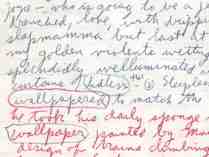
Anastasi’s obsessive cross-referencing of texts and journals has the feel of an pre-typewriter era Ph.D thesis. Unless you’re his advisor, you don’t want to read it — just absorb the poundage.
Lest you think this is tomfoolery, let me tell you that Anastasi, the influential conceptual artist and friend of John Cage, presented his thesis to a gathering of Joyce scholars at the Sorbonne…and that it was mostly well-received.
Anastasi’s thesis has two arguments — that Joyce admired Jarry (1873-1907) and refers to the father of Pataphysics all over the place in his texts; and that Duchamp — who never admitted to it publicly — was also a Jarry man. Neither Joyce nor Duchamp came right out and admitted the Jarry connection. (image below is portrait of Jarry)
[for more on Duchamp, check out this comprehensive, interactive site]
The artist thinks Joyce is to literature what Duchamp is to art. Both are revolutionaries.

As I found out at Rosenbach, repository of James Joyce’s hand-written manuscript of “Ulysses,” Anastasi, 71, is a natural raconteur, full of energy and charm. By turns serious and self-deprecating, the artist was a name dropper; he was funny; he was frank; he made the conceptual underpinnings of his work clear. And he made you interested in it. The fifty folks who packed the Rosenbach on a sunny Spring-like afternoon sat for two full hours to hear his stories. (photo of the artist below)
By the way, I learned from artnet that Anastasi’s 1968 camouflage installation is featured currently in New York at White Box Annex.
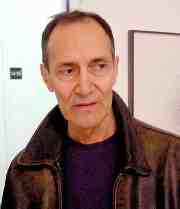
Here are a few of my notes from the rambling discussion. (My note-taking accounts for some Dada-esque leaps from subject to subject, sorry.)
William Anastasi: I always thought there was a Joyce and Duchamp connection. Joyce exploded literature and Duchamp exploded art. And the Duchamp-Jarry connection looks obvious. They both use sexuality via machines. Jarry talks about man as a machine who can make love forever. He has a female robot. He talks about a machine/bride…
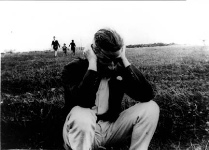
Jean Michel Rabate: Jarry is mostly known for the Ubu plays. He had a big influence on French culture. He invented pataphysics…the science of imaginary solutions.
WA: [about Joyce and Duchamp] Joyce after Ulysses published little things and spent all his time thinking. It’s like Duchamp playing chess….and they both made disappointing works at the end. (photo of Joyce)
[Ed. note: previously, this post included a parenthetical after the disappointing works comment listing Finnegan’s Wake and Etant Donee as the presumed disappointments. Anastasi wrote me to say he never said that Finnegan’s Wake and Etant Donee were disappointing works. My mistake.
Quoting from Anastasi’s email:
I have never said or thought anything like this (that Finnegan’s Wake or Etant Donne are disappointing works) — quite the opposite. Finnegans Wake is a unique masterpiece and I have regarded it so for a half century plus. Etant Donnes is likewise unique. (Also) ‘coprophiliac’ is the correct spelling for your “cacafiliast.”]
WA: All three thought accident was divinity. They thought beauty was everywhere. “I stumble on a stone and it’s exactly what I need.”
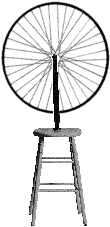
I only met Duchamp once but I became very close to Teeny.
Jarry said “Death is for the common man” Duchamp said his epitaph should be “Death always comes to the other guy.”
Joyce used literary ready mades. He copied from the TLS, sometimes randomly….he’d excuse himself at a party and go to the bathroom and leave the door open and copy conversations. People got wise and got mad at him. You wonder why the dialog in Joyce is so loopy?
[Somebody said] “Good artists borrow, great artists steal.” (image above is Duchamp readymade)
Here’s a tip for any poets in the audience. If you go on a subway and copy dialog from one ear and then from the other, that’s great poetry.
There’s not one page in Finnegan’s Wake that doesn’t have erotica or scatological material. Duchamp said the erotic is the only thing that interests me.
Aaron Levy: In our brochure essay, Jean Michel and I called you a demented archivist. We didn’t know if you would like that.
WA: Thank you. That’s almost as good as coprophiliac (someone obsessed with feces — a term applied to Jarry and Joyce).
AL: Why is that a compliment?
WA All I have is my aesthetic prejudice of the moment. My aesthetic prejudice moves, maybe because I’m a runner. I’ve run every day for the last 36 years. I’ve never met anyone who could say that. I’ve never drunk coffee. Never. I’ve never met anyone else who could say that.
There’s a distance between me and the multitude.
“Taste is habit.” These three words are enormously important for life and art.
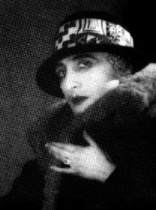
There are thousands of things out there that are better than mom’s lasagna. We are very provincial.
When I started this project I had nothing to lose. At the Sorbonne I was attacked by one man but I won him over. Also, I got caught up in it. For me it was relaxation…like chess for Duchamp. It’s a fascinating world I’d never come across.
[about Cindy Sherman’s photographs of herself dressed up] I wonder if Cindy Sherman will be a footnote to Rrose Selavy [Duchamp’s alter ego–image above] or if Rrose Selavy will be the footnote for Cindy Sherman. (image below)
Duchamp said the title is the most important part of the piece.
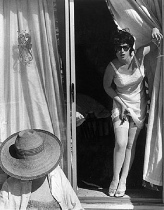
What Jarry, Joyce and Duchamp have in common? Their total indifference to the audience.
By the way, I’ve been poor and rich and poor and rich. I’m serious.
One time I went to a bookstore and asked how many copies of Finnegan’s Wake they had. Thirteen. I said they’re sold. I brought them home and said this thing is a work of art. I’ve been reading Finnegan’s Wake every day since I was 19. Like I draw every day. When I have insomnia I can draw but I can’t read except Finnegan’s Wake, out loud. Try it when you have insomnia.
JMR: What you do is art and scholarship
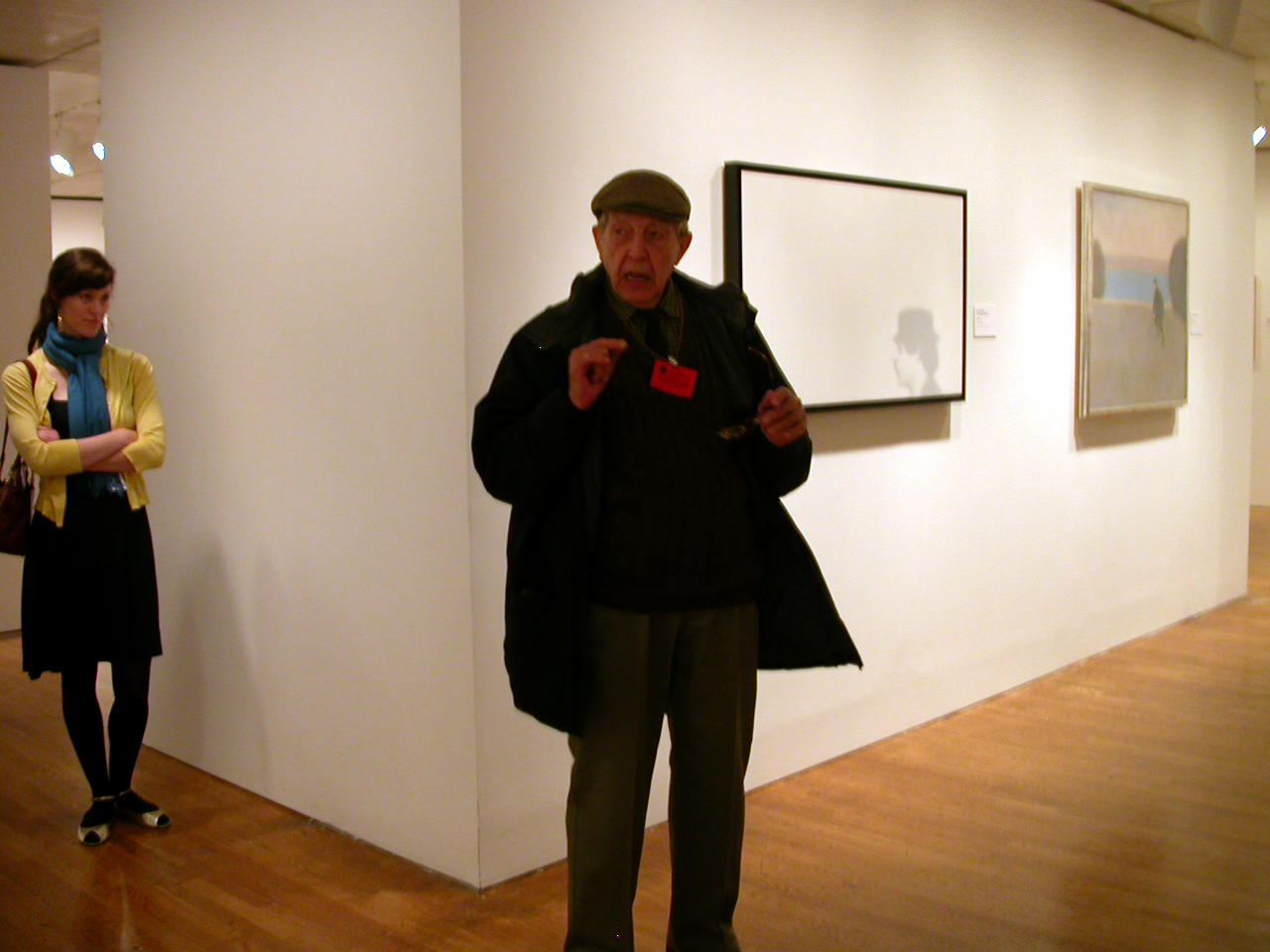
WA I have my suspicions and that’s what it boils down to….Jarry equates all art with masturbation. He predicts that even after the end of the world there will be a machine making art, our need to make it is so great.
Tom Chimes: [sitting in front row, the Philadelphia artist known for his dreamy portraits of Jarry and others–see image above] What was your hypothetical audience?
WA: I didn’t have one. Myself. I didn’t see this as my work. It was my hobby. That’s why I was good at it….
[about why Duchamp never stated his admiration for Jarry] Picasso openly embraced Jarry… Also, like Joyce said, we always keep the dearest person to ourselves.









